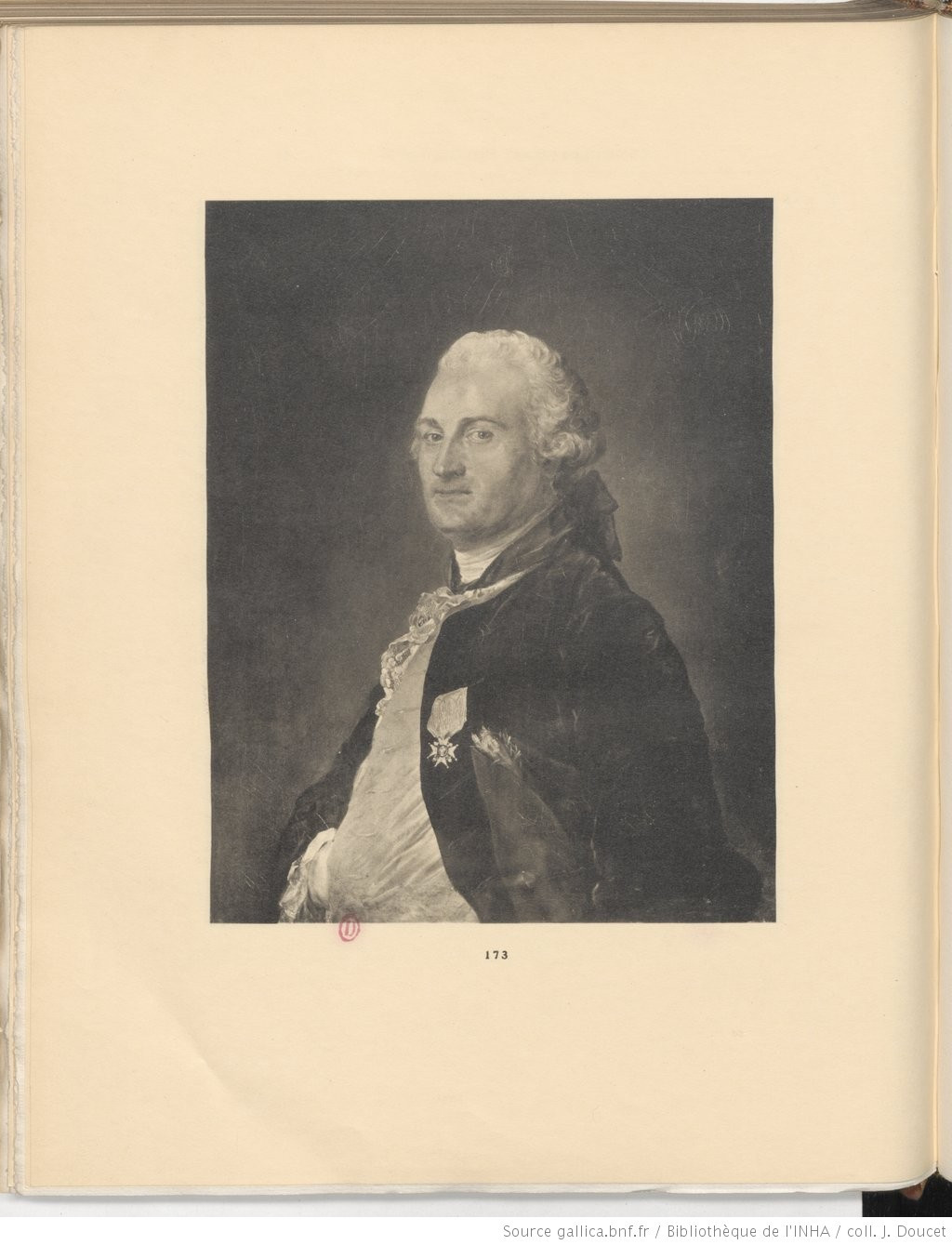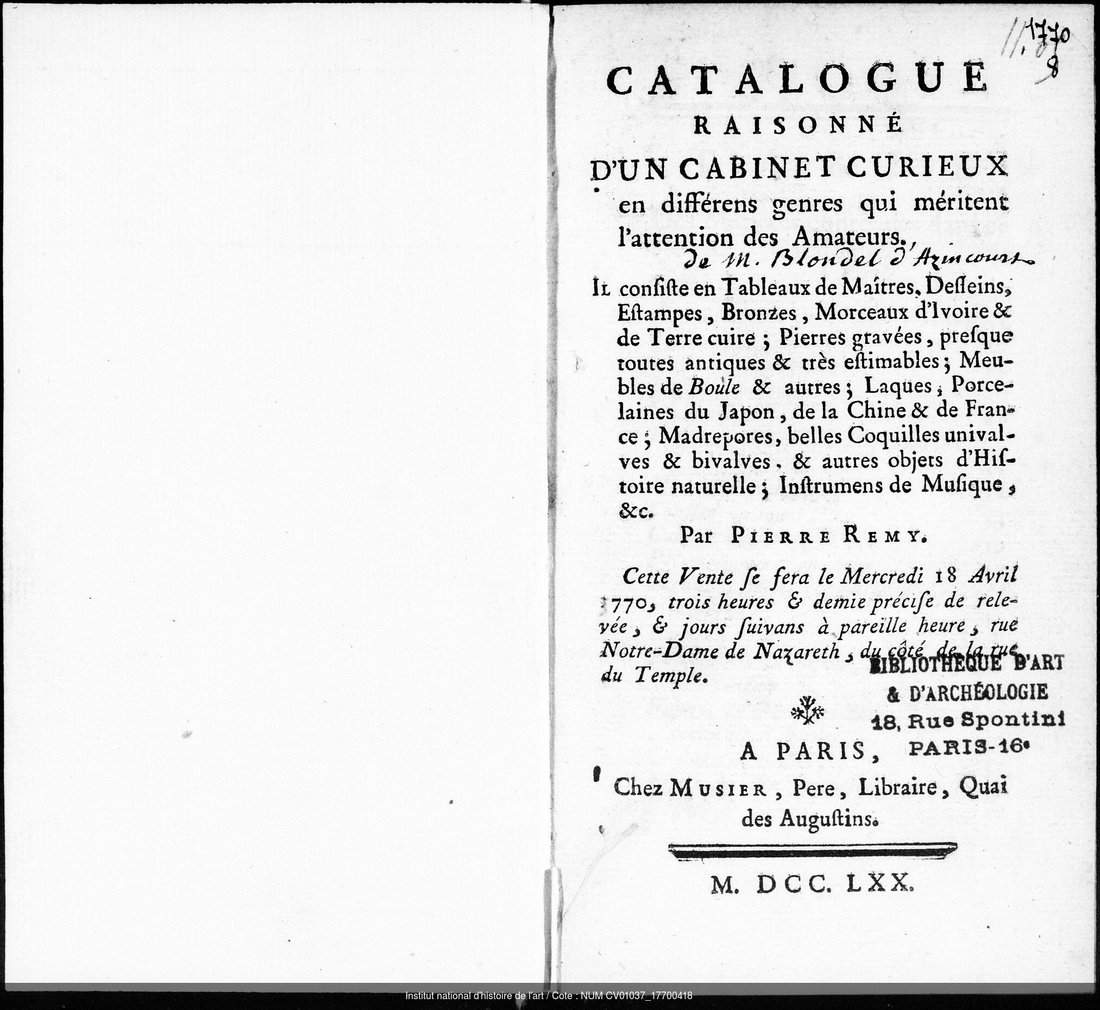
BLONDEL D'AZINCOURT Barthélemy-Augustin (EN)
Family Origins
Barthélémy Augustin Blondel d’Azincourt was born on June 6, 1719, in Paris, and died there on May 31, 1794 (Bailey C. B., 1987, p. 434). His father was Augustin Blondel de Gagny (1695-1776),treasurer general of debts, intendant of the Menus-Plaisirs, and a major collector. His mother was Henriette Marguerite Barbier (deceased 1730). On December 3, 1752, Barthélémy Augustin Blondel d’Azincourt married the niece of farmer-general Charles Marin Delahaye (1684 1753), Catherine Charlotte Edmée Delahaye des Fossés (1734-1808) [AN, MC/LVII/404]. Together they had a daughter, Charlotte Marie Blondel d’Azincourt, who married Emmanuel Marie, Marquis de Tragin, Baron de Cohardon, Musketeer of the Second Company on on May 22, 1775 (AN, MC/LVII/523). A wealthy financier, Blondel de Gagny generously bequeathed his son 300,000 pounds (AN, MC/LVII/529), to which he added the position of intendant and comptroller general of the silver (intendant et contrôleur général de l’argenterie), evaluated at 200,000 pounds (AN, O1/98/f. 178).
Career and Distinctions
Blondel d'Azincourt was captain in the Normandy regiment in 1744, then lieutenant-colonel in the infantry (AN, MC / LVII / 404) and distinguished himself during the War of the Austrian Successionin 1745. He received the cross of the Royal and Military Order of Saint-Louis (Bailey C. B., 1987, p. 434), visible on the presumed portrait of the collector painted by Jean-Baptiste Perronneau (1715-1783) [private collection]. The model, represented in a bust, is turned three quarters in a natural attitude. His physiognomy is close to the description given in the collector's death and residence notice, found in the national archives: “[…] five foot five inches, brown eyes, angular nose, medium mouth, round chin, white hair, oval face, uncovered brow” (AN, F / 7/5613, file 4).
In 1754, Blondel d´Azincourt succeeded his father as intendant counsellor and controller general of the silver, feasts, and affairs of the king’s chamber (contrôleur général de l’Argenterie, Menus-Plaisirs et Affaires de la chambre du roi) (AN, V / 1/380, room 9). In this capacity, he was in charge of the organization of court ceremonies and performances.

Artistic Training
Unlike some contemporaries who began their professional career by gradually climbing the rungs of social hierarchy, such as Nicolas Beaujon (1718-1786), Blondel d'Azincourt inherited a name, an office, prestige and therefore a reputation, which allowed him to devote himself more quickly and with more investment to the practice of collecting. Blondel d'Azincourt was the son of the wealthy collector Augustin Blondel de Gagny (1695-1776) and was educated in art by his father from an early age. He also likely frequented his father's friends, particularly his artistic and professional circle, such as the connoisseur financier Pierre-Paul Randon de Boisset (1708-1776). Additionally, he was very involved in the arrangement of the cabinets of connoisseurs, so much so that in 1749 he wrote a treatise for the use of the latter, entitled La Première Idée de la curiosité, which describes the ideal arrangement and composition of a cabinet, the names of the best Flemish painters, and details on their activity (Bailey CB 1987, p. 431-437). He was a free associate in the Royal Academies of Painting and Sculpture of Paris and Marseille as of the year 1767 (Bailey, C. B., 1987, p. 435) and was recognised both as a draughtsman and as an engraver. His productions were mostly dispersed during the sale of his cabinet in 1783 (catalog of the Blondel d´Azincourt sale, Paillet A.-J., Julliot, P.-F., Paris: Prault, 1783).
The Collection
Blondel d'Azincourt's very ample and diverse collection reflects the taste of an enlightened connoisseur, who was able to add to and enrich his father's collection of paintings, which he acquired during the sale after the latter's death (Rémy P., Paris: Prault, 1776). Two sales during Blondel d'Azincourt's lifetime allow us to assess the richness of his cabinet and the variety of objects collected (sales catalogs of Blondel d'Azincourt, Rémy P., Paris, Musier père, 1770, and Paillet A. -J., Julliot, P.-F., Paris: Prault, 1783).
In April 1770, Pierre Rémy (1715-1797) was commissioned to sell nearly 500 lots, including paintings from the Italian, Dutch and Flemish schools, but above all from the French. There were also drawings, prints, curiosities, porcelain from Japan, China and France, and a significant number of seashells and antique engraved stones, which established Blondel d'Azincourt's reputation for having an inquisitive mind (catalog from the Blondel d'Azincourt sale, Rémy P., Paris: Musier père, 1770). In his Dictionnaire pittoresque et historique, Hébert (active mid-18th century, dates of birth and death unknown) writes: "Mr. Blondel d´Azincourt [...] formed this cabinet, which is very interesting due to the variety and selection of the objects which compose it. It deserves the full attention of connoisseursand the curious. This cabinet is in a different style from that of his father Mr. Blondel de Gagny […]. For this reason, Blondel d´Azincourt preferred a few beautiful modern paintings, fine sketches and a very large number of drawings, among which one should take particular notice of nearly five hundred by Boucher. This cabinet also includes 160 carved cameo stones, Egyptian as well as Etruscan, Greek and Roman, almost all of which come from the princes of Palavicini, and have survived for endless times in this illustrious house. M. Narcisse de Thoret acquired it in 1699 […]. Well-chosen bronzes, old porcelains, lacquer of the greatest finesse, and an infinite multitude of objects seductive to the eyes also leave a sensation in the mind which proves that pleasure must be in harmony with art, and that perfection consists in their union. It is in nature itself that one can seek and discover this principle. One can easily be convinced of this principle without ever leaving this cabinet, which contains items as rare as they are curious, namely a series of minerals, crystallizations, agates, precious stones, madrepore, coral, and shells [ …]” (Hébert, 1766, p. 81-83). This remarkable mineralogy cabinet is also described by merchant-mercier Lazare Duvaux (1703-1758): “Blondel d'Azincourt's beautiful cabinet […] has been assembled with the greatest taste, by the precious pieces to be seen in the various categories of shells, arranged mainly on a table placed in the middle of the room for natural history; this table is white and richly decorated with gilding, octagonally shaped, rising in a pyramid and turning on a pivot; it is surrounded and covered by mirrors […]. The other rooms contain a fine suite of seventy cameo or engraved stones, both Greek and Roman; a ring sizer of fine stones, with several vases of topaz and jasper. Glasses of rock crystal, another cut from a piece of amber”(Courajod L. [ed.], 1873, p. CCXXXI-CCXXXIII).
These descriptions highlight the variety of objects collected by Blondel d´Azincourt, whose cabinet was especially admired for its curiosities and its mineralogical collections. It should be emphasised that this interest was rather unique at the time, when the majority of collectors rather appreciated the three schools of painting. The Blondel d´Azincourt collection, however, was also made up of fine works by old and modern masters; this is evidenced by the second sale in February 1783, directed by Alexandre Joseph Paillet (1743-1814) and Philippe-François Julliot (1755-1836) [catalog of the Blondel d'Azincourt sale, Paillet A.-J., Julliot P.-F., Paris: Prault, 1783]. The sale took place at the Hôtel de Louvois, rue de Richelieu. The catalog notice specifies that a large part of the lots, in particular the paintings, came from the former cabinet of Blondel de Gagny: “What is detailed and offered in today’s catalog is largely indebted to the famous collection of the late M. Blondel de Gagny. Connoisseurs will particularly recognise it with the paintings, each of which is either the most important of that Master, or a perfect sample of his most esteemed productions.” Several paintings are mentioned that remain famous today: L’Enfant prodigue by David Teniers (1610-1690) [Paris, musée du Louvre, inv. 1878]), Le Marché aux herbes d’Amsterdam by Gabriel Metsu (1629-1667) [Paris, musée du Louvre, inv. 1460], and Le Charlatan by Karel Dujardin (1626-1678) [Paris, musée du Louvre, inv. 1394]. Some marble figures complete this beautiful painted set, in particular L’Amour tenant une flèche, appuyé sur un tronc d’arbre by Jacques François Saly (1717-1776), which was formerly kept in the collection of the Marquise de Pompadour and is currently in the Louvre (inv. RF 2016.2.1). The focus, however, is on the remarkable collection of engraved stones and expertly described antique cameos.
With Blondel d´Azincourt, as with other amateurs of the period, we find a particular interest in porcelain and lacquerware from the Far East. The collectors preferred the porcelain of Japan, called “ancient Japan”, “ancient Japanese white”, “ancient Japanese coloured porcelain”, “ancient coloured Japan of the first class”, or “first coloured quality”, which for the delicateness of its paste prevailed over that of China (“ancient coloured China”, “ancient coloured porcelain of China”) [Castelluccio S., 2013, p. 150-151]. The more light and delicate decor of the Japanese pieces was a choice criterion. During his second sale, Blondel d´Azincourt offered around a hundred porcelains from Japan. In his treatise on the interior arrangement, the amateur recommends mixing porcelains with bronze to enhance their color (Bailey C. B., 1987, p. 149). We can therefore assume that in his home, the connoisseur had arranged his porcelain, sculptures, and paintings in a harmonious manner, seeking an aesthetic effect.
Apart from the paintings formerly in the Blondel de Gagny cabinet, the provenance of the lots in the Blondel d'Azincourt collection is poorly detailed. On the other hand, it is easier to determine the new buyers, annotated in the margins of the catalogs: we thus find the dealers Claude François Julliot (1727-1794), who notably acquired certain porcelains, Alexandre Joseph Paillet (1743-1814 ), Pierre François Basan (1723-1797), Jean Baptiste Pierre Le Brun (1748-1813), and Vincent Donjeux (17? -1793), as well as the most prestigious collectors of the 18th century: Nicolas Beaujon (1718-1786) and Louis XVI.

Related articles
Personne / personne

Collection / collection d'une personne

